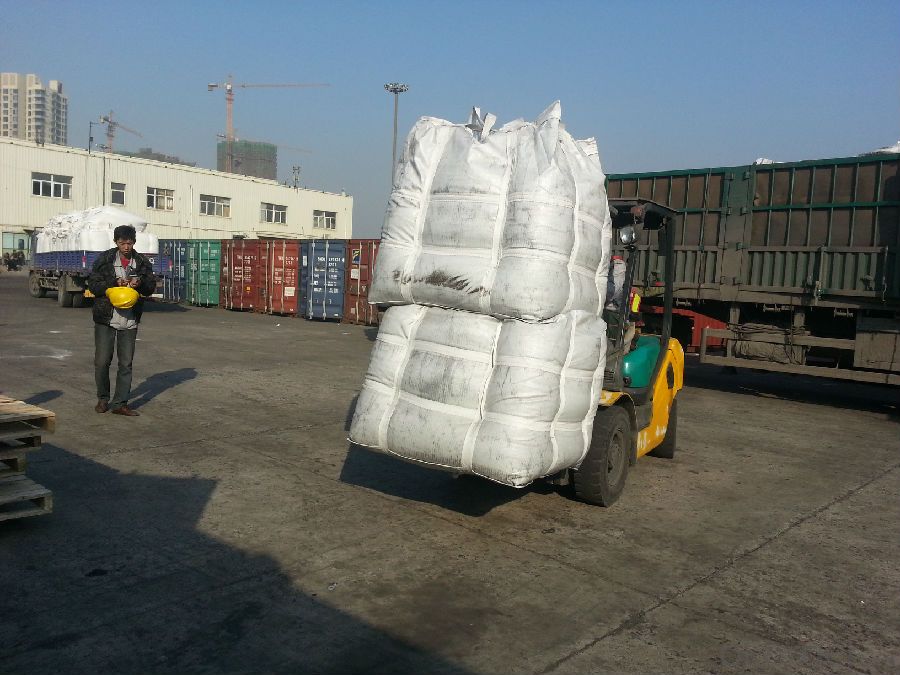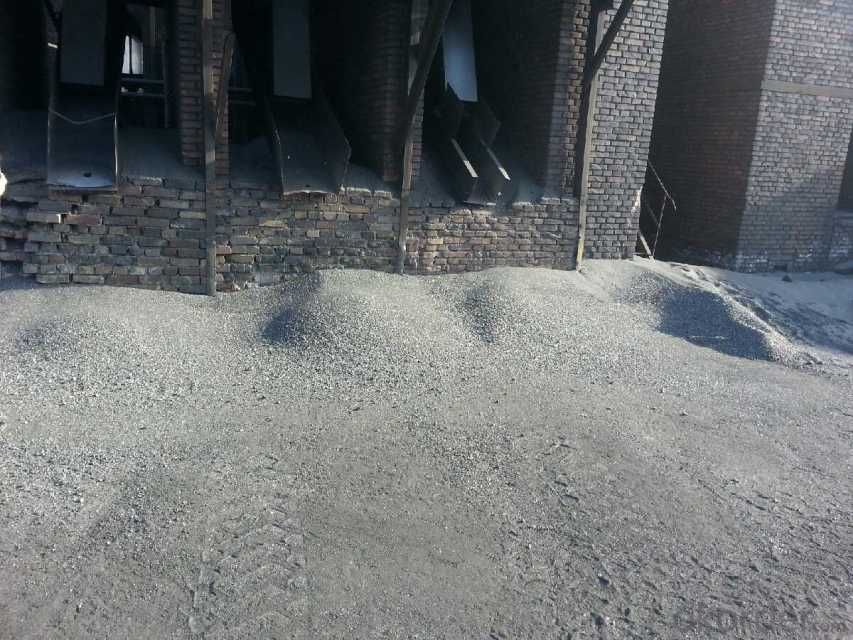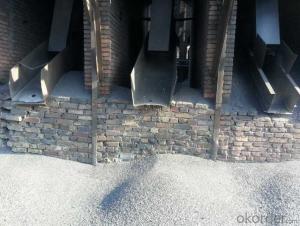FC92 Charge Coke with good and stable quality
- Loading Port:
- Tianjin
- Payment Terms:
- TT OR LC
- Min Order Qty:
- 20 m.t.
- Supply Capability:
- 3000 m.t./month
OKorder Service Pledge
OKorder Financial Service
You Might Also Like
Packaging & Delivery
25kgs/50kgs/1ton per bag or as buyer's request
Specifications
Calcined Anthracite
Fixed carbon: 90%-95%
S: 0.5% max
Size: 0-3. 3-5.3-15 or as request
Advantage and competitive of caclined anthracite:
1. strong supply capability
2. fast transportation
3. lower and reasonable price for your reference
4.low sulphur, low ash
5.fixed carbon:95% -90%
6..sulphur:lower than 0.3%
It used the high quality anthracite as raw materials through high temperature calcined at over 2000 by the DC electric calciner with results in eliminating the moisture and volatile matter from anthracite efficiently, improving the density and the electric conductivity and strengthening the mechanical strength and anti-oxidation. It has good characteristics with low ash, low resistvity, low sulphur, high carbon and high density. It is the best material for high quality carbon products.
General Specification of Calcined Anthracite:
| FC % | 95 | 94 | 93 | 92 | 90 |
| ASH % | 4 | 5 | 6 | 6.5 | 8.5 |
| V.M. % | 1 | 1 | 1 | 1.5 | 1.5 |
| S % | 0.3 | 0.3 | 0.3 | 0.35 | 0.35 |
| MOISTURE % | 0.5 | 0.5 | 0.5 | 0.5 | 0.5 |
Pictures



- Q:The main difference between steel and iron is the difference in carbon content
- The essential difference between steel and iron is that there is a difference in carbon content.1, steel, is a carbon content, mass percentage of 0.02% to 2.04% between the ferroalloy. The chemical composition of steel can have great changes, only the carbon steel is called carbon steel (carbon steel) or ordinary steel; in actual production, steel tend to use different with different alloy elements, such as manganese, nickel, vanadium and so on;2 iron is a chemical element. Its chemical symbol is Fe. It has an atomic number of 26. It is the most common metal. It is a kind of transition metal. A metal element with a second highest crustal content.Extension of knowledge point:Iron into pig iron and wrought iron. Wrought iron, steel and cast iron is an alloy of iron and carbon with the carbon content difference. Generally less than 0.2% carbon content that wrought iron or iron, the content of 0.2-1.7% in the steel, is iron content of more than 1.7%. Soft wrought iron, good plasticity, easy deformation, strength and hardness were lower, not widely used; iron carbon, hard and brittle, almost no plastic; steel pig iron and wrought iron with two kinds of advantages, widely used for human.
- Q:What are the impacts of carbon emissions on the stability of polar ice caps?
- Carbon emissions have significant impacts on the stability of polar ice caps. The increased concentration of carbon dioxide in the atmosphere, primarily due to human activities, leads to global warming. This rise in temperature causes the polar ice caps to melt at an accelerated rate. As a result, the ice caps shrink, leading to rising sea levels and increased coastal flooding. The loss of ice also disrupts ecosystems and threatens the survival of various species, such as polar bears and seals, which depend on the ice for their habitat and food sources. Overall, carbon emissions play a major role in destabilizing the polar ice caps and pose grave consequences for both the environment and human populations.
- Q:Yes, I have a weapon, want to strengthen 11, said to be advanced furnace rock carbon, do not know how to get, look at the prawns pointing
- To strengthen the ordinary senior rock colorless, furnace carbon is used advanced, the mall did not buy, according to that wish gift box can be opened in some special activities in the last device can be bought in, no other time
- Q:What is the density of carbon steel and alloy steel?
- Material name density g/cm3Grey cast iron 7.7.7Malleable iron 7.7.4Cast steel 7.8Industrial pure iron 7.87Plain carbon steel 7.85Quality carbon steel 7.85Carbon tool steel 7.85Free cutting steel 7.85
- Q:How is carbon dating used to determine the age of fossils?
- Carbon dating is a scientific method used to determine the age of fossils and other organic materials. It relies on the fact that carbon-14, an isotope of carbon, is present in the atmosphere and taken up by living organisms while they are alive. Once an organism dies, it no longer takes in carbon-14 and the amount of this isotope begins to decrease over time as it undergoes radioactive decay. To determine the age of a fossil using carbon dating, scientists first extract a small sample of the fossil. This sample is then treated with chemicals to remove any contaminants and extract the carbon from the organic material. The extracted carbon is then converted into carbon dioxide gas, which is used to create graphite targets for measuring the levels of carbon-14. Scientists use a technique called Accelerator Mass Spectrometry (AMS) to count the number of carbon-14 and carbon-12 atoms in the sample. The ratio of carbon-14 to carbon-12 is then used to calculate the age of the fossil, based on the known half-life of carbon-14, which is approximately 5730 years. By comparing the amount of carbon-14 remaining in the fossil to the amount of carbon-14 in the atmosphere at the time the organism died, scientists can determine the approximate age of the fossil. This method is particularly useful for dating organic materials up to about 50,000 years old. For older fossils, other methods such as potassium-argon dating or uranium-lead dating are typically used.
- Q:What are the impacts of carbon emissions on human health in developing countries?
- Carbon emissions have significant impacts on human health in developing countries. These emissions, primarily from the burning of fossil fuels and deforestation, contribute to the worsening of air quality, leading to a range of health problems. One of the most immediate and visible impacts is respiratory diseases. High levels of carbon emissions result in the release of harmful pollutants such as particulate matter and nitrogen dioxide. These pollutants can irritate the respiratory system and exacerbate existing conditions like asthma and bronchitis. In developing countries where access to healthcare may be limited, these respiratory diseases can be particularly detrimental, leading to increased mortality rates. Furthermore, carbon emissions contribute to climate change, which has indirect effects on human health. Rising temperatures and changing weather patterns can lead to the spread of vector-borne diseases like malaria and dengue fever. Developing countries often lack the necessary infrastructure and resources to effectively combat these diseases, resulting in increased rates of infection and mortality. Moreover, carbon emissions contribute to the formation of ground-level ozone, a harmful air pollutant. Exposure to high levels of ozone can cause respiratory problems, cardiovascular issues, and even premature death. Developing countries, with their limited access to healthcare and vulnerability to extreme weather events, may experience higher rates of illness and mortality due to ozone exposure. Additionally, carbon emissions contribute to the acidification of oceans, which harms marine ecosystems. This, in turn, affects the availability and quality of seafood, a vital source of nutrition for many developing countries. Impaired access to nutritious food can lead to malnutrition and various health issues, especially among vulnerable populations such as children and pregnant women. In conclusion, carbon emissions have severe impacts on human health in developing countries. The release of pollutants from burning fossil fuels and deforestation leads to respiratory diseases, the spread of vector-borne illnesses, ozone-related health problems, and nutritional deficiencies. These health impacts highlight the need for developing countries to prioritize sustainable development and transition to clean energy sources, while also emphasizing the importance of international cooperation to address this global issue.
- Q:What are carbon credits and how do they work?
- Carbon credits are a market mechanism designed to reduce greenhouse gas emissions. They work by assigning a monetary value to each ton of carbon dioxide or other greenhouse gases that are not released into the atmosphere. This value is assigned through a process called carbon offsetting, which involves investments in projects that reduce emissions, such as renewable energy projects or reforestation initiatives. These projects generate carbon credits, which can be bought and sold by companies or individuals to offset their own emissions. By purchasing carbon credits, entities can effectively compensate for their own carbon footprint and contribute to global efforts in mitigating climate change.
- Q:What kinds of carbon black paper do you have?
- Classification of weights:Carbon free carbon paper has 45g/m2CB paper, 47g/m2CF paper and 52g/m2CFB paper according to quantitative. Carbon free carbon paper is divided into 80 parts: 48, 50 and 80: 52: below: 47 and 2.55-60 grams for office reports, receipts, delivery orders, delivery lists, etc..Two. Classification of specifications:Carbon free carbon paper can be divided into web (rools) and paperboard (sheets) according to specifications. The width of the web can range from 160mm to 1940mm, and the size of the flat paper can range from 420mm*530mm to 1420mm*1420mm.
- Q:How does carbon affect the formation of acidification in lakes?
- Lakes undergo acidification due to the significant role played by carbon dioxide (CO2). Human activities, such as burning fossil fuels, release carbon dioxide into the atmosphere. This carbon dioxide can then be absorbed by lakes, resulting in the formation of carbonic acid (H2CO3), a weak acid. When carbonic acid interacts with water, it dissociates into hydrogen ions (H+) and bicarbonate ions (HCO3-). The increase in hydrogen ions causes a decrease in pH levels, making the water more acidic. This process is commonly referred to as acidification. The acidification of lakes can have detrimental effects on aquatic ecosystems. It negatively impacts the physiology and behavior of various species, including fish, amphibians, and invertebrates. Furthermore, the eggs and larvae of these organisms can be damaged by acidic waters, hindering their growth and survival. Acidification also has the potential to disrupt the composition and abundance of phytoplankton, which are vital for maintaining the overall health of the ecosystem. Additionally, high levels of acidity can result in the leaching of toxic metals, such as aluminum, from the surrounding soil and rocks. These toxic metals then dissolve in the water, posing an additional threat to aquatic organisms. Acidification can also disrupt the nutrient cycles in lakes, ultimately affecting the availability of essential nutrients for plants and animals. To summarize, the presence of carbon dioxide in the atmosphere contributes to the acidification of lakes when it is absorbed by water. This acidification has a range of negative impacts on the aquatic ecosystem, including altered physiology, impaired reproduction, and disrupted nutrient cycles. It is imperative to reduce carbon emissions and mitigate the effects of acidification to safeguard the health and diversity of lake ecosystems.
- Q:Search for a summary of the importance of carbon in life. If you write well, you can add points,
- The carbon containing compounds exist in hundreds of thousands, divided into inorganic and organic compounds in two categories, known as carbon containing inorganic substances in daily life and industrial and agricultural production is the raw material of carbon calcium carbonate as food additive sodium, sodium bicarbonate, calcium carbonate and lime material acetylene gas (acetylene), chemical fertilizer ammonium bicarbonate, chemical gases such as carbon dioxide.
1. Manufacturer Overview |
|
|---|---|
| Location | |
| Year Established | |
| Annual Output Value | |
| Main Markets | |
| Company Certifications | |
2. Manufacturer Certificates |
|
|---|---|
| a) Certification Name | |
| Range | |
| Reference | |
| Validity Period | |
3. Manufacturer Capability |
|
|---|---|
| a)Trade Capacity | |
| Nearest Port | |
| Export Percentage | |
| No.of Employees in Trade Department | |
| Language Spoken: | |
| b)Factory Information | |
| Factory Size: | |
| No. of Production Lines | |
| Contract Manufacturing | |
| Product Price Range | |
Send your message to us
FC92 Charge Coke with good and stable quality
- Loading Port:
- Tianjin
- Payment Terms:
- TT OR LC
- Min Order Qty:
- 20 m.t.
- Supply Capability:
- 3000 m.t./month
OKorder Service Pledge
OKorder Financial Service
Similar products
New products
Hot products




























